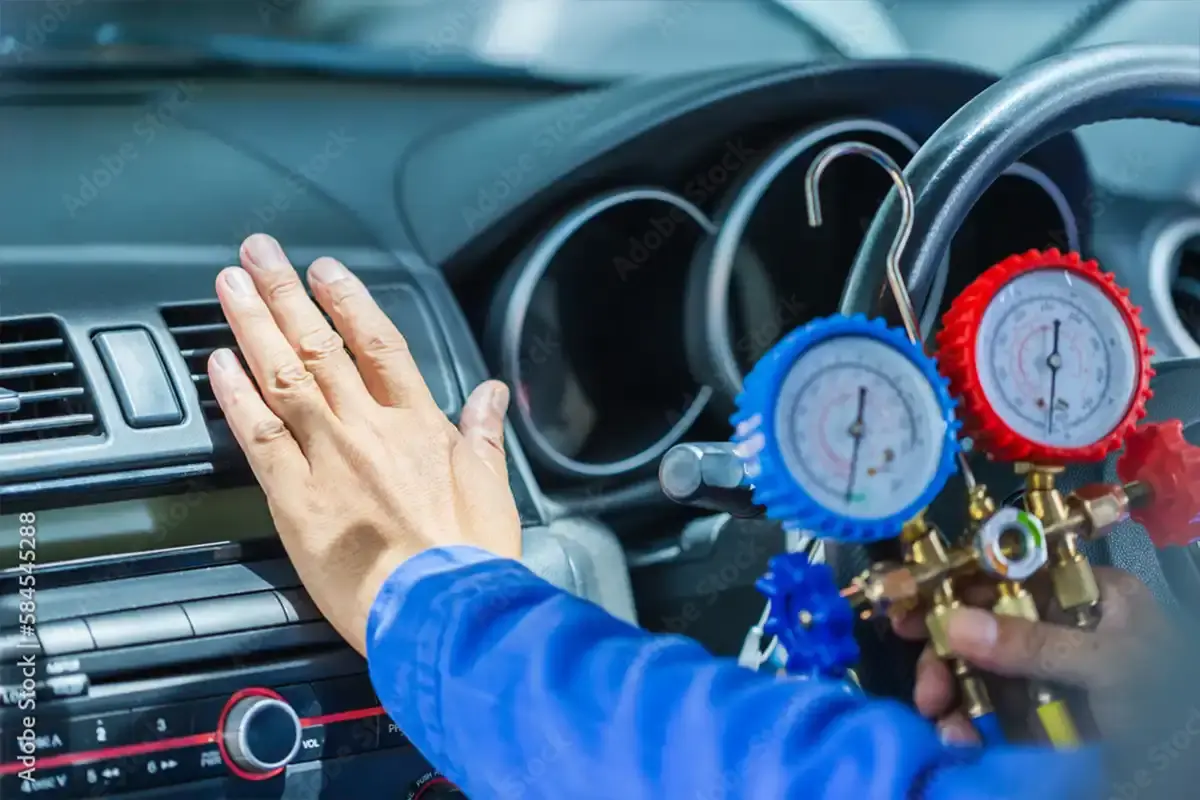What Is the AC System and How Does It Work?
Your AC removes heat and moisture from cabin air. The compressor pressurizes refrigerant, the condenser releases heat, the expansion valve/orifice drops pressure, and the evaporator absorbs heat inside the cabin while the blower moves air across it. Modern vehicles use R‑134a or R‑1234yf refrigerant plus special oil to lubricate the compressor. Proper pressures, charge weight, fans, and blend doors are all crucial for icy-cold, reliable AC.
Why AC Health Matters
- Comfort in hot weather and fast window defogging for safety
- Prevents compressor damage from running low on refrigerant or oil
- Protects electrical and HVAC components from overheating and moisture
- Keeps energy use and fuel economy in check
Important to Know
- AC systems are sealed. If it’s low on refrigerant, there’s a leak that needs repair—recharging alone is temporary.
- R‑1234yf systems use pricier refrigerant and require dedicated equipment; we service both R‑134a and R‑1234yf.
- Whenever the system is opened, a new receiver/drier or accumulator is recommended to protect the compressor.
- Many modern condensers are non‑flushable; contamination often requires condenser replacement with compressor jobs.
- Evaporator core or heater core replacements may require dash removal; we’ll quote and schedule accordingly.
- We follow EPA regulations for recovery, evacuation, and recharge—no venting.
How AC Repair Is Done
- Verify Concern
Confirm poor cooling, airflow, odors, or noises; check vent temps and HVAC controls. - Visual & Electrical Checks
Inspect belt/drive, compressor clutch, cooling fans/relays, fuses, and condenser condition. - Gauge Readings & Scan
Read high/low side pressures, ambient and vent temps; scan for HVAC and engine codes. - Recover, Measure, and Vacuum
Safely recover refrigerant to see how much was in the system; deep vacuum to remove air/moisture and perform a vacuum hold test. - Leak Detection
UV dye, electronic leak detector, or nitrogen pressure test to pinpoint leaks at hoses, O‑rings, service ports, condenser, evaporator, or compressor seals. - Repair/Replace Components
Replace failed parts (O‑rings, hoses, condenser, compressor/clutch, expansion valve/orifice, receiver/drier, pressure switches, cooling fans, blend door actuators). Add correct PAG oil and dye as needed. - Recharge to Exact Spec
Evacuate and recharge with the precise factory weight of R‑134a or R‑1234yf. - Performance Verification
Check vent temps, pressure balance, compressor cycling, fan operation, and recheck for leaks. Provide a digital report and estimate for any additional recommendations.
Common AC Repairs We Handle
- Refrigerant leak repairs: O‑rings, hoses, service valves, condenser, compressor seals
- Compressor and clutch replacement (with oil balancing and system cleaning)
- Condenser and receiver/drier/accumulator replacement
- Expansion valve or orifice tube replacement
- Cooling fan, relay, and pressure sensor repairs
- Blend/mode door actuator and HVAC control diagnostics
- Blower motor and resistor replacement
- Cabin air filter replacement and evaporator drain cleaning
- AC recharge (R‑134a and R‑1234yf) after leak repair and verification
When to Service the AC
- Weak cooling, only cool while driving, or warm at idle
- Compressor not engaging or rapid cycling
- Visible dye or oily residue at AC fittings or condenser
- Musty odors, foggy windows, or water dripping inside the cabin
- After collision/condenser damage or any AC component replacement
- Every 2–3 years: performance check and cabin filter replacement (varies by vehicle and climate)
Signs You May Need AC Repair
- Warm air with AC on, or temperature fluctuates
- Hissing, squealing, or grinding from the engine bay
- Clicking under the dash; air only from certain vents
- AC light on or HVAC fault codes
- Burning smell or excessive moisture inside the vehicle
How Important Is This Service?
High. Running an undercharged or contaminated system can quickly damage the compressor and drive costs up. Nationwide Mechanics finds the root cause, fixes leaks correctly, and recharges to spec so your AC blows cold and stays reliable.
What You Get with Top Notch Mobile Repair LLC
- EPA‑certified, mobile HVAC technicians
- Service for R‑134a and R‑1234yf systems
- Precise evacuation and recharge by weight
- OEM or equivalent parts and new seals/hardware where required
- Digital report with photos, vent temps, and pressure readings
- Upfront pricing; diagnostic credited toward approved repairs
- Convenient at‑home or office service




